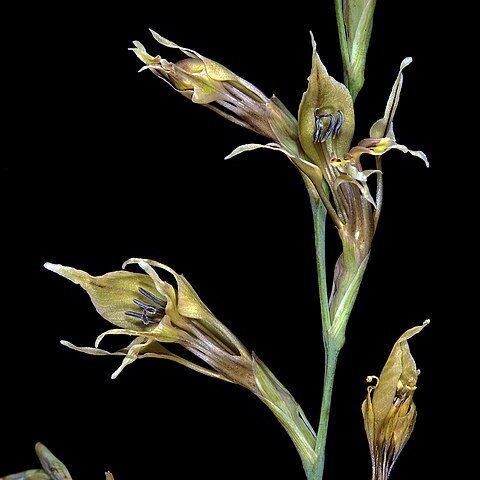Plants 150-600 mm high. Corm globose to conic, 8-12 mm diam.; tunics medium to coarsely fibrous. Stem usually erect, flexed outward above sheath of third leaf, simple or 1-or 2(4)-branched. Leaves usually 4 to 7, more in highly branched plants, lower 4 to 6 basal in loose fan, usually reaching at least to middle or shortly exceeding spike, linear or subsucculent and oval in section, 1.0-2.0(-3.5) mm wide, rigid, central area moderately thickened, margins sometimes lightly thickened, cauline leaves shorter, often without blade, upper either sheathing below or diverging from base. Spike inclined, lightly flexuose, 4-to 8-flowered; bracts pale greyish green sometimes flushed purplish, often dry and pale near apices, outer (7-)12-18(-24) mm long, inner shorter to almost as long, acute or minutely forked. Flowers whitish to greenish cream-coloured, dull blue-grey, dull purple, or yellow-brown, upper tepals or at least upper laterals each with brown to purplish longitudinal median stripe, lower tepals and throat streaked reddish to purplish, limbs usually yellow in lower 1/2 often edged distally with darker colour, often strongly sweet-scented or scentless; perianth tube obliquely funnel-shaped, 9-13(-15) mm long, slender lower part 7-10 mm long; tepals narrowed below into claws and ± spade-shaped, attenuate, sometimes extremely so, dorsal largest, (16-)20-33 x 10-15 mm, inclined over stamens, spreading distally, upper laterals arching outward distally, 16-23 x 7-8 mm, windowed between bases of dorsal and upper lateral tepals, lower 3 tepals joined to upper laterals for 2-5 mm and together for 3-6 mm with small thickened knobs at sinuses, free parts 14-16 x 6-8 mm, narrowed below into claws 2-4 mm long, abruptly flexed downward into a broader limb. Filaments 12-16 mm long, exserted 8-13 mm from tube; anthers 5-9 mm long, dull cream-coloured to grey-purple; pollen whitish. Style arching over stamens, dividing between base and apex of anthers, branches 1.5-4.0 mm long. Capsules ovoid-ellipsoid, (6-)9-16 x 5-6 mm. Seeds oval, 4-6 x 3-4 mm, broadly and sometimes unevenly winged.
More
Perennial herb, geophyte, 0.20-0.45 m high; corm globose to conic; stem usually erect, flexed, simple or 1-or 2-branched. Leaves 4-7, linear, 1.0-2.0(-3.5) mm wide; midrib and margins thickened. Bracts pale grey-green, sometimes flushed purplish above. Inflorescence a 4-8-flowered spike, inclined, flexuose; flowers whitish to greenish cream-coloured, dull blue-grey, dull purple or yellow brown; upper tepals with brown to purplish longitudinal median stripe; lower tepals and throat streaked reddish to purplish; perianth tube obliquely funnel-shaped; tepals unequal, attenuate, dorsal largest, inclined over stamens, arching near apex. Stamens exserted; anthers dull cream-coloured to grey-purple; pollen whitish. Ovary oblong; style arching over stamens. Flowering time Aug.-Dec. Capsule ovoid-ellipsoid, 3-lobed, emarginate at apices.
Cormous geophyte, 200-400 mm tall, with wiry corm tunics. Leaves linear to terete, 1-3 mm wide. Flowers several in a secund spike, bilabiate, windowed in profile, mauve to dull purple or cream, often with yellowish markings, usually intensely fragrant, dorsal tepal largest, arching over stamens, lower tepals narrow.
Cormous geophyte, 30-50 cm, tunics fibrous. Leaves linear-terete, whip-like. Flowers bilabiate, windowed in profile, cream-coloured to brownish or mauve usually with yellowish markings.

